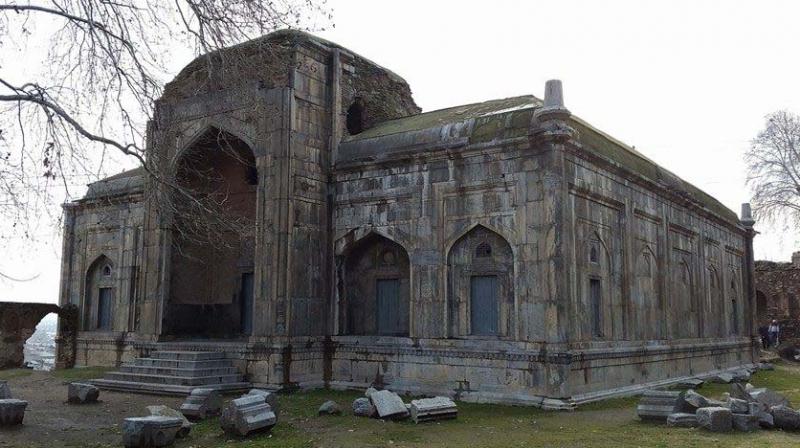Weekend special: Historic sites in Kashmir fall prey to ASI 'neglect'

Srinagar: Many of 50 plus archaeological sites across Kashmir Valley are in dilapidated condition after these were virtually abandoned by Archaeological Survey of India (ASI) with the start of insurgency more than 27 years ago.
The ASI’s Srinagar Circle Headquarters were shifted to winter capital Jammu and have not returned to their original place since. Ironically, the centrally protected monuments in the Valley have been left unattended and, with no renovation or repair work taking place at most of these as is required under the relevant provisions of the law for so long, many of these sites are crumbling.
Take for instance Akhund Mullah mosque on the foothills of Hari Parbat or Koh-e-Maran built by Mughal prince Dara Shikoh for honouring his tutor Mullah Akhund Shah in A.D.1649. The mosque built of grey limestone and it lotus final over the pulpit being the only example of its kind surviving in Kashmir is in shambles. But since it is a centrally protected monument under the ASI, no repair or renovation work can take place through individual or community initiative. “It is the ASI which under the provisions of the relevant law has to do it and salvage it from being ruined completely,” said Khalid Bashir Ahmed, a former government official.
The other historical monuments and sites which are decaying due to the neglect include ancient site and remains at Burzahom near Srinagar which reveals a three-fold cultural sequence, starting from the Neolithic period and succeeded by Megalithic and early historical cultures, and another one at Chakradhar, Semthan.
Also the condition of Shiva temple, Pandrethan, ancient monasteries and stupas at Harwan, Ushkura, Devar, Yakhmanpora and Parihaspora, Chankracharya temple, Srinagar, groups of ancient temples at Naranag, Martand, Buniyar, Ladhuv, Fatehgarh and Tapper, Waripora, Avantiswamin and Avantisvara temples at Awantipora, ancient Shiva temple at Payer, Shankargaurisvara temple and excavated structures and Sugandesha temple at Pattan, Detha Mandir at Bandi, Bumzuva cave and temple at Bumzuva, ancient temple, Kakpora, Tomb of king Zain ul-Abidin’s mother at Zaina Kadal, Srinagar, the nearby Khanka-e-Moula mosque, Khanpur Sarai, Khanpur, Gates in The Rampart of the Fort Kathi Darwaza and Sangeen Darwaza in Srinagar, Mughal Arcade including the spring at Verinag, Srinagar’s Pather Masjid or Stone Mosque, Groups of arched terraces/ structural complex, Pari Mahal, Srinagar, ancient temple dedicated to goddess Sharika on the foothills of Hari Parbat are not any good as all have virtually been abandoned or left at the mercy of local caretakers.
The Srinagar Circle of the ASI is operating from Gandhi Nagar area of Jammu and is being headed by a Superintending Archaeologist (SA). The sources in J&K government said that the SA along with his entire staff, except Conservation Assistant, a very junior level employee, migrated to Jammu more than twenty-five years ago, leaving the centrally protected monuments in the Valley virtually unattended. “The persistent requests and decisions taken to shift the Circle Headquarter back to Srinagar are not heeded to,” said one of them.
However, the ASI officials claim that the 56 centrally protected monuments under its Srinagar Circle “are being looked after well” even though from Jammu at a distance of nearly 300 kilometres. They claimed that their structural conservation and environmental development are carried out for their better preservation on regular basis. But visits to some of these sites belie the claim. The portions of the wall adjacent to the gates to the rampant of Srinagar’s Hari Parbat, the site of a Durrani Fort built in 1808, are falling apart. Also sections of the fortifications on the site constructed by Mughal emperor Akbar in 1560 who built an outer wall for the fort as part of his plans for a new capital called Nager Nagor collapsed in or immediately after the September 2014 floods in the Valley but no repair work has been taken up so far.
The ASI officials also said that tenders for taking up repair and renovation work at some of the important sites in Srinagar and Pulwama district were invited recently and subsequently executed or are being executed, as well.
The Department of Archaeology was established in Jammu and Kashmir State in 1904 by Maharaja Ranbir Singh. It subsequently merged with ASI in 1958 and was named as Frontier Circle. At present, its Srinagar Circle is looking after the “maintenance and upkeepment” of 59 monuments located in Kashmir Valley and Jammu region of the State. In 2010, a separate mini circle was created at Leh to look after the monuments of Ladakh region.

